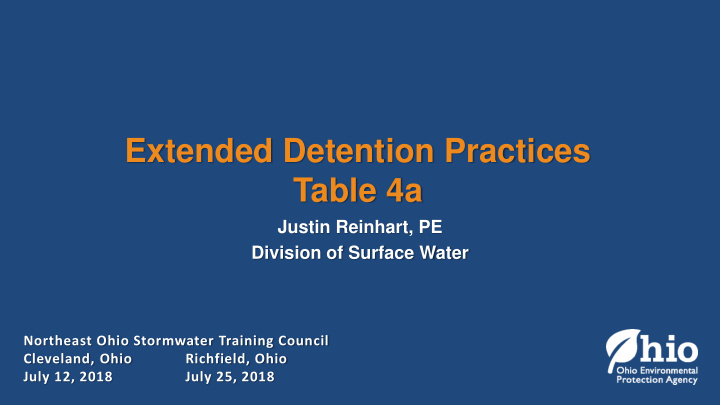



Extended Detention Practices Table 4a Justin Reinhart, PE Division of Surface Water Northeast Ohio Stormwater Training Council Cleveland, Ohio Richfield, Ohio July 12, 2018 July 25, 2018
Table 4a Extended Detention Post-Construction Practices with Minimum Drain Times Extended Detention Practices Minimum Drain Time of WQv Wet Extended Detention Basin 1,2 24 hours Constructed Extended Detention Wetland 1,2 24 hours Dry Extended Detention Basin 1,3 48 hours Permeable Pavement – Extended Detention 1 24 hours Underground Storage – Extended Detention 1,4 24 hours Sand & Other Media Filtration – Extended Detention 1,5 24 hours • What did the Construction General Permit change ? • What may change in the RWLD manual ? • Common issues / challenges
Dry Extended Detention Basin What did the permit change ? – Allows for acceptable pretreatment in place of a forebay and micropool. – Must include a protected outlet. What will be changing in the RWLD Manual ? – Standards for acceptable pretreatment practices and protected outlet. (Appendix 10)
Dry Extended Detention Basin Acceptable alternatives must be equivalent to a forebay & micropool: – Remove 50% of annual TSS load. – Require minimal maintenance and oversight for long-term functioning of the extended detention volume. – Prevent scour/erosion at pipe outfalls.
Pretreatment Alternatives Grass Swale Vel. ≤1 ft/s @ d ≤ 4 in. W = 4 ft. to 8 ft. L ≥ 50 ft. S ≤ 4% (< 1% may be an issue) IMAGE SOURCE: VA DEQ Stormwater Design Specification No. 10
Pretreatment Alternatives
Pretreatment Alternatives Grass Filter Strip Full width of pavement L ≥ 10 ft. Dense turf
Pretreatment Alternatives
Pretreatment Alternatives Manufactured Treatment Device Still need erosion/scour protection at basin inlet.
Pretreatment Alternatives Deep Sump Trap or Catch Basin Possible for small drainage areas: parking lot catch basin (6 ft dia.) 4 ft x 28.3 ft 2 = 113 ft 3 @ 10%, WQv = 1,132 ft 3 ~ 1,600 ft 2 max. impervious d.a. IMAGE SOURCE: USEPA
Dry Forebay… Possibly • Not much research • Need to develop standards • May need test sites
Dry Forebay… Possibly 10% - 20% WQv Concept based on: UDFCD, Urban Storm Drainage Criteria Manual Vol. 3 (2015) 72-hr Drawdown ? Permeable Dike
Dry Forebay… Possibly IMAGE SOURCE: NJ Stormwater BMP Manual, Chapter 9.5 Infiltration Basins
Dry Forebay… Possibly Impermeable Dike Concept based on: New Jersey Stormwater Manual, Chapter 9.5 72-hr Drawdown ? Weep Hole / Pipe Concrete
Protected Outlet
Protected Outlet
Protected Outlet
Protected Outlet Micropool Micropool Micropool
Protected Outlet
Protected Outlet
Protected Outlet
Protected Outlet IMAGE SOURCE: www.ads-pipe.com/products/pipes/advanedge-panel/advanedge-site-drain-pipe
Protected Outlet “The filter under drain system at Carver County dry detention pond exhibited poor hydraulic performance and failed to keep the pond dry between the storm events.” “Continual maintenance is required to maintain the filter system in an operational condition.” -Minnesota DOT. 2006. Water Quality Performance of Dry Detention Ponds with Under-Drains. Mn/RC-2006-43.
Protected Outlet Agricultural “blind inlet” to field tile 24-hr drawdown
Protected Outlet “designed to catch sediment and therefore, eventually fail and require maintenance”
Dry Extended Detention Basin Pool Volume = WQv + 20% sediment Pool Volume = WQv + 10% forebay + 10% micropool
Wet Extended Detention Basin What did the permit change ? – Permanent pool volume and extended detention volume are now both equal to the WQv (was ¾ WQv). What will be changing in the RWLD Manual ? – Not much.
≥ WQv +20% Sediment Storage ≥ WQv +20% Sediment Storage
Extended Drawdown • Wet & underground: 24-hour minimum • Dry: 48-hour minimum • Shall not discharge more than the first half of the WQv in less than one-third of the drain time.
Extended Drawdown
Extended Drawdown
Extended Drawdown
Extended Drawdown
Extended Drawdown
Extended Drawdown
Extended Drawdown
Extended Drawdown – 2” Min. • As designed, the acre basin with a 1⅝ in. diameter orifice. • What if the local authority has a minimum 2 in. orifice diameter requirement ?
Extended Drawdown – 2” min.
Extended Drawdown – 2” min.
Underground Stormwater Management Systems
Underground Stormwater management Systems What did the permit change ? – Added infiltrating and extended detention USMS as standard practices pre-approved for general use. – Requires pretreatment at verified efficacy. What will be changing in the RW&LD Manual ? – Provisional standard has been posted. – Welcome input.
USMS – Ext. Det. Pretreatment • Verified 50% TSS removal. • Can use NJDEP list. • Max treatment flow rate/hydraulic loading @ WQf. • Size according to each inlet. • Can be used in parallel, but does not increase TSS removal.
Infiltrating System Open System Pre-T Flood 80% TSS @ Flood Control WQF Verified Control Outlet WQv @ d ≤ IWS Infl. Rate Volume No Sediment Storage
Extended Detention System All Solid Wall Pre-T Flood WQ, FC & WQv 50% TSS @ Control Overflow Outlets WQF Volume Wet Sump (20% Sediment)
Extended Detention System Lined Pre-T WQ Outlet Flood Flood Control & 50% TSS @ . Control Overflow Outlets WQF Contained Volume Wet Sump WQv (20% Sediment)
Extended Detention System Partially Infiltrating Pre-T 50% TSS @ WQv Flood Outlets WQF above Control Wet Sump IWS Volume Infiltration (20% Sediment)
Multiple Entry Points
Multiple Entry Points
Multiple Entry Points
WQ Outlet Configuration
Maintenance Feasibility • Access manholes at inlet, outlet and within storage as necessary for cleaning. • Observation wells.
Maintenance Feasibility • Costs ? • Depth ? • Surface Accessibility ? • How Often ? • How ? SOURCE: “Maintaining Stormwater Systems”, Northern Virginia Regional Commission, 2007
Post-Construction O & M Plan site map w/ stormwater infrastructure
Storm Water Technical Assistance justin.reinhart@epa.ohio.gov 614-705-1149
Recommend
More recommend